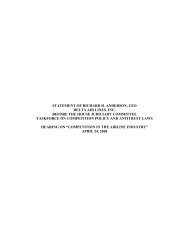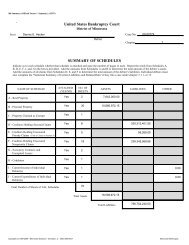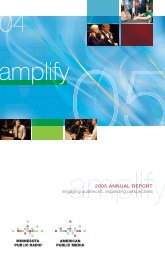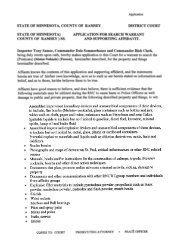Stephen Cornell and Jonathan Taylor - American Public Media
Stephen Cornell and Jonathan Taylor - American Public Media
Stephen Cornell and Jonathan Taylor - American Public Media
You also want an ePaper? Increase the reach of your titles
YUMPU automatically turns print PDFs into web optimized ePapers that Google loves.
Sovereignty, Devolution, <strong>and</strong> the Future<br />
of Tribal-State Relations<br />
We are grateful for the invitation from the<br />
National Congress of <strong>American</strong> Indians to attend<br />
the mid-year session in Juneau <strong>and</strong> offer<br />
some observations <strong>and</strong> thoughts on the state of<br />
tribal-state relations. Our remarks st<strong>and</strong> back a<br />
bit from the particular circumstances of any one<br />
state-tribal relationship to examine the overall<br />
state of those relations, the changes that are<br />
reshaping them, <strong>and</strong> the implications of those<br />
changes for Indian nations.<br />
Three Trends <strong>and</strong> the Uncertain Future of<br />
Tribal-State Relations<br />
At the start of the 21 st century, three broad<br />
political developments or trends are reshaping<br />
tribal-state relations. The future of those relations<br />
is unclear, but the interaction among these<br />
trends <strong>and</strong> the relative influence of each will do<br />
a great deal to determine not only the shape of<br />
those relations but the future of Indian nations.<br />
The first of these political developments is<br />
devolution: the effort to shift decision-making<br />
power downward in the political structure from<br />
central to local governments. Devolution is based<br />
on the reasonable proposition that policy is best<br />
made at the smallest level of government capable<br />
of doing so. With this in mind, over the last<br />
decade <strong>and</strong> around the globe, central governments<br />
have been devolving power down to local<br />
levels. The United States has been an eager<br />
participant in this trend. The New Federalism,<br />
the Seminole decision, the Contract with America,<br />
<strong>and</strong> welfare reform are all facets of <strong>American</strong><br />
devolution. Together with other court <strong>and</strong><br />
legislative developments, they constitute a significant<br />
transfer of decision-making power from<br />
the federal government to the states. As a result,<br />
the states have more discretion, more<br />
flexibility, more authority, <strong>and</strong> more control<br />
over federal dollars—in short, more practical<br />
<strong>Stephen</strong> <strong>Cornell</strong> <strong>and</strong> <strong>Jonathan</strong> <strong>Taylor</strong><br />
National Congress of <strong>American</strong> Indians<br />
Mid-Year Session<br />
Juneau, Alaska, June 26, 2000<br />
1<br />
sovereignty—than they used to, <strong>and</strong> they are<br />
using it to rethink public policies <strong>and</strong> tailor<br />
them to local circumstances. It is too soon to<br />
know how far this trend will go—a great deal<br />
hinges on how well the states perform as they<br />
assume greater authority <strong>and</strong> launch new programs<br />
of their own—but the basic trend is clear.<br />
Relative to federal power, state sovereignty is<br />
growing <strong>and</strong> will continue to grow.<br />
Of course devolution has a history in Indian<br />
Country as well. For the last twenty-five years,<br />
federal policy toward tribes, formally at least,<br />
has been devolutionary. Self-determination—<br />
which is a devolutionary policy—ideally places<br />
power in tribal h<strong>and</strong>s, reducing federal controls<br />
over tribal affairs, resources, <strong>and</strong> decisions. Indeed,<br />
one might see the self-determination policy<br />
toward Indian nations as a precursor of the<br />
more general devolutionary tendency in the<br />
United States.<br />
Combined with vigorous tribal political assertions<br />
over that same period, this has produced<br />
the second political development that is<br />
reshaping tribal-state relations as we start the<br />
new century: the resurgence of tribal power.<br />
Across the country, albeit to varying degrees,<br />
Indian nations have been taking greater control<br />
of their own affairs, implementing practical selfrule.<br />
The evidence is everywhere, from 638 contracting<br />
to 472 compacting, from the gaming<br />
industry to wildlife management <strong>and</strong> l<strong>and</strong> use,<br />
from foster care to TANF programs. Tribal control<br />
is nowhere absolute, but as a practical matter<br />
it has grown enormously since the 1960s as<br />
more <strong>and</strong> more Indian nations have moved aggressively<br />
to exercise substantive decisionmaking<br />
power across a wide range of issues<br />
critical to tribal futures.
Yet this resurgent tribal power is anything<br />
but secure. And this brings us to the third political<br />
development reshaping tribal-state relations:<br />
through the 1990s <strong>and</strong> continuing today, tribal<br />
sovereignty has been under assault in the courts,<br />
in Congress, in the states, <strong>and</strong> now, possibly, in<br />
the presidential campaign. We need not revisit<br />
here the potential or actual effects on tribes of<br />
the Venetie or Seminole decisions by the Supreme<br />
Court, the 638 moratorium, the Istook<br />
Amendment, means-testing for TPA, or the<br />
revenue-sharing compact proposals in the gaming<br />
industry. Tribal leaders feel those impacts<br />
in their daily work. But we should note that<br />
there is a growing body of research showing that<br />
the assault on tribal sovereignty holds grave<br />
risks not only for the political future of Indian<br />
nations but for their economic future as well.<br />
Sovereignty, it turns out, is a critical economic<br />
asset for Indian nations. 1 The effort to reduce<br />
tribal sovereignty is perhaps the most risky <strong>and</strong><br />
misconceived public policy trend affecting tribes<br />
since allotment.<br />
The critical question for the future of tribalstate<br />
relations <strong>and</strong> for the future of Indian nations<br />
themselves has to do with which of these<br />
trends—or which combination of them—prevails.<br />
There is little doubt about devolution. It<br />
has broad political support <strong>and</strong> seems unlikely<br />
to be reversed any time soon. The question is:<br />
will this shift in power away from the federal<br />
government work to tribes’ advantage or not?<br />
In <strong>and</strong> of itself, devolution is not dangerous<br />
to tribes. Quite the reverse: devolution has the<br />
potential to significantly boost tribal self-rule.<br />
But the ultimate impact of devolution depends<br />
on what happens to the other two trends identified<br />
here. Will devolution include Indian nations<br />
<strong>and</strong> embrace the resurgence in tribal power? If<br />
so, then there are grounds for new, robust, government-to-government<br />
relationships between<br />
Indian nations <strong>and</strong> the states. Or will the assault<br />
on sovereignty, combined with a form of<br />
devolution that refuses to recognize Indian nations<br />
as sovereign, self-governing entities, lead<br />
to a dramatic realignment of governmental<br />
1 On this point, see in particular the research findings<br />
of the Harvard Project on <strong>American</strong> Indian Economic<br />
Development (for example, <strong>Cornell</strong> <strong>and</strong> Kalt 1992,<br />
1998, <strong>and</strong> in press).<br />
2<br />
power, strengthening states <strong>and</strong> weakening<br />
tribes? If that turns out to be the case, then the<br />
political <strong>and</strong> economic future of Indian nations<br />
is very much in doubt.<br />
Not coincidentally, research also suggests<br />
that in the first scenario—a scenario of sustained<br />
tribal sovereignty—the burdens on federal<br />
<strong>and</strong> state governments <strong>and</strong> taxpayers generated<br />
by reservation poverty are likely to decrease.<br />
In the second scenario—a scenario of<br />
diminished tribal power—they almost certainly<br />
will rise.<br />
In what follows, we first review the arguments<br />
often heard against genuine, governmentto-government,<br />
sovereignty-based relationships<br />
between tribes <strong>and</strong> the states. We then review<br />
the arguments for such relationships. We close<br />
with a summary of the implications for tribalstate<br />
relations <strong>and</strong> with a quick look at the<br />
tasks facing tribal governments as they attempt<br />
to shape the outcome of these trends <strong>and</strong> build<br />
productive tribal-state relationships based on<br />
mutual respect for sovereignty.<br />
Arguments against Tribal-State<br />
Cooperation<br />
One consequence of devolution is already<br />
apparent. We’ve been talking to tribal leaders<br />
around the country about the changing nature<br />
of tribal-state relations, <strong>and</strong> their general impression<br />
is summarized by one planner’s view<br />
that “We never used to think about the state.<br />
We just dealt with the federal government. Now<br />
we have to think about the state all the time.”<br />
States <strong>and</strong> tribes are involved in each other’s<br />
business a great deal more than they used to be.<br />
Whether it is the Navajo Nation’s work with<br />
Arizona on culturally appropriate definitions of<br />
“work” under welfare reform, or the contentious<br />
negotiations in many states over gasoline tax<br />
collections, states <strong>and</strong> tribes are being forced to<br />
deal with each other on numerous matters of<br />
policy. They have locked horns over hazardous<br />
<strong>and</strong> nuclear waste, wildlife management, foster<br />
care, off-reservation fishing, gaming compacts,<br />
taxation of all kinds, auto licensing, policing,<br />
<strong>and</strong> other issues—in sum, over nearly every<br />
facet of tribal life. States <strong>and</strong> tribes also have<br />
cooperated on most of these same issues. In<br />
short, tribes <strong>and</strong> states are in relationships that<br />
are much more complex <strong>and</strong> uncertain than ever
efore, <strong>and</strong> their interactions have ranged from<br />
the highly contentious to the mutually respectful<br />
<strong>and</strong> beneficial.<br />
Indeed, one of the puzzles of tribal-state relations<br />
is why in one state there is little or no<br />
cooperation in a given policy area while in a<br />
neighboring state, tribe <strong>and</strong> state are cooperating<br />
with success on the same issues. In one<br />
state, the governor <strong>and</strong> legislature may resist<br />
cooperation with tribes, relying on the courts or<br />
lobbying Congress to limit tribal sovereignty.<br />
Right next door, the state <strong>and</strong> the tribes may<br />
view each other as partners, proactively negotiating<br />
solutions to mutual challenges. Why is<br />
that?<br />
Some of it has to do with history. Where<br />
animosity characterizes tribal-state relations,<br />
the core of the conflict may be deep-seated mutual<br />
distrust or even racism, built up over decades.<br />
Nonetheless, historical animosities cannot<br />
explain everything, <strong>and</strong> states have put forward<br />
a number of arguments against tribal sovereignty<br />
<strong>and</strong> a government-to-government relationship<br />
with tribes. Several themes often appear<br />
in these arguments: 2<br />
i) a zero-sum view of tribal-state relationships<br />
in which one party’s gain in sovereignty<br />
or economic resources is the other<br />
party’s loss, <strong>and</strong> vice versa,<br />
ii) a view that tribal governments are not<br />
“competent” governments, <strong>and</strong><br />
iii) a view that allowing tribes to have<br />
regulatory authority will lead to a “race<br />
to the bottom” in which states will have<br />
to compete with tribes by accepting ever<br />
greater risks or costs.<br />
Each of these needs some elaboration.<br />
Zero-Sum Tribal-State Relationships<br />
Governments often view their conflicts with<br />
other governments as inherently zero-sum: one’s<br />
2 Our list of themes is hardly exhaustive; a number of<br />
arguments against tribal sovereignty have been<br />
made. These are ones we frequently encounter <strong>and</strong> to<br />
which some of our own research speaks.<br />
3<br />
gain in sovereignty or economy is the other’s<br />
loss <strong>and</strong> vice-versa. Wildlife management is an<br />
example. Some states have taken the position<br />
that tribal assertions of game management<br />
authority are a direct challenge to state sovereignty.<br />
If a tribe controls game management,<br />
the state will not be able to control its herds,<br />
flocks, <strong>and</strong> fish stocks as they migrate on <strong>and</strong> off<br />
the reservation, <strong>and</strong> the tribe’s actions will diminish<br />
state regulatory effectiveness. In this<br />
view, tribes are seen by states as obstacles to<br />
the exercise of newly devolved state powers.<br />
In the economic arena, some states have<br />
taken the position that tribal economic gains are<br />
costly to the states. The costs, in this argument,<br />
generally come either in lost revenues as tribes<br />
capture dollars from non-Indian vendors, reduce<br />
state tax revenues, or otherwise move dollars<br />
into tribal h<strong>and</strong>s, or in increased state burdens<br />
as reservations export pollution, social problems,<br />
or some other cost to the surrounding region.<br />
Gaming is a common example. Some states<br />
argue that tribal gaming moves dollars from the<br />
state to tribes while “exporting” problem gamblers<br />
to the states. This idea leads states to resist<br />
gaming compacts or to insist on taxing Indian<br />
gaming through revenue sharing agreements.<br />
The Competence of Tribal Governments<br />
A second public policy argument that seems<br />
to carry force when tribes <strong>and</strong> states are tussling<br />
over sovereignty is that tribal governments<br />
are not “competent” in the exercise of<br />
governing powers. If states concede any authority<br />
to tribes or if they try to negotiate with<br />
them, the argument goes, tribes will bungle the<br />
job <strong>and</strong> the states not only will bear the brunt of<br />
repairing the damage but will end up st<strong>and</strong>ing<br />
in for the tribes anyway. The argument often is<br />
reinforced by resort to anecdotal evidence of<br />
tribal mismanagement, corruption, <strong>and</strong> the like.<br />
This argument is implicit in much of the<br />
Congressional backlash against Indian selfdetermination<br />
as well as in state resistance to<br />
the tribal exercise of sovereignty. As misinformed<br />
as it may be, it often prevents fruitful<br />
tribal-state cooperation.
Races to the Bottom<br />
Some of the critics of devolution argue that<br />
it pits government against government in a<br />
“race to the bottom” to make regulations less<br />
<strong>and</strong> less stringent in order to attract business.<br />
For example, the critics of the New Federalism<br />
argue that as states compete with each other for<br />
business, they will move toward the least common<br />
denominator in environmental or workplace<br />
regulation, welfare benefits, taxation, <strong>and</strong><br />
the like, trying to capture business from or shift<br />
costs to other states.<br />
Similarly, critics of tribal sovereignty argue<br />
that less developed tribes will be more willing to<br />
accept hazardous wastes, relax worker safety<br />
regulation, or be otherwise overeager to attract<br />
businesses by lowering st<strong>and</strong>ards. Tribal sovereignty,<br />
in this argument, means lax regulation<br />
that will either (a) force the state to compete<br />
with the tribe by loosening its own st<strong>and</strong>ards,<br />
eventually harming the public good, or (b) put<br />
the state economy, state workers, or the state<br />
environment at risk as the effects of lax tribal<br />
st<strong>and</strong>ards spill off the reservations into non-<br />
Indian communities <strong>and</strong> the state as a whole.<br />
Adherents of these various views use them<br />
to argue against recognizing the inherent sovereignty<br />
of tribes <strong>and</strong> as justifications for asserting<br />
state jurisdiction rather than establishing<br />
government-to-government partnerships with<br />
Indian nations. They promote a devolutionary<br />
pattern in which state power grows relative to<br />
tribal power, <strong>and</strong> tribal self-determination becomes<br />
increasingly hostage to state actions.<br />
Arguments for Sovereignty-Based, Tribal-<br />
State Cooperation<br />
While these arguments clearly are dangerous<br />
to tribes, there also is ample evidence that<br />
they are simply wrong. Furthermore, we believe<br />
they also are potentially costly to the states.<br />
Tribes <strong>and</strong> states around the country are demonstrating<br />
that there are good reasons for tribalstate<br />
cooperation on a government-togovernment<br />
basis that respects the sovereignty<br />
of each.<br />
4<br />
Positive-Sum Tribal-State Relationships<br />
The zero-sum view of tribal-state relationships<br />
holds that each party in that relationship<br />
gains primarily at the other’s loss. There are<br />
grounds for this view in certain situations. For<br />
example, a single dollar of gasoline-tax revenue<br />
cannot be split without one party’s gain being<br />
the other party’s loss. But this zero-sum phenomenon<br />
is by no means always present in<br />
tribal-state relations.<br />
The fact is that capable <strong>and</strong> sovereign tribal<br />
governments advance state goals as well as<br />
tribal goals. No state has an incentive to allow<br />
the kind of poverty <strong>and</strong> economic underdevelopment<br />
that has characterized Indian reservations<br />
for so long to continue to fester within its<br />
borders. That said, twelve years of research at<br />
the Udall Center <strong>and</strong> Harvard Project emphasizes<br />
that tribal control over tribal affairs is the<br />
only policy that works for economic development.<br />
We have been unable to find a single reservation<br />
where major decisions are controlled by<br />
outsiders—the states, the federal government,<br />
or special interests—where successful economic<br />
development has taken root. In short, if states<br />
want Indian poverty <strong>and</strong> its off-reservation consequences<br />
to be adequately addressed, they<br />
have to stop insisting that their rules apply to<br />
the exclusion of tribes’ rules. The evidence is<br />
compelling that where tribes have taken advantage<br />
of the federal self-determination policy to<br />
gain control of their own resources <strong>and</strong> of economic<br />
<strong>and</strong> other activity within their borders,<br />
<strong>and</strong> have backed up that control with good governance,<br />
they have invigorated their economies<br />
<strong>and</strong> produced positive economic spillovers to<br />
states.<br />
Gaming is the easiest example to point to.<br />
In 1998 we carried out the most comprehensive<br />
study yet undertaken of the economic <strong>and</strong> social<br />
impacts—on <strong>and</strong> off reservations—of Indian<br />
gaming. It showed significant contributions to<br />
off-reservation economies. 3 Some quick examples:<br />
First: casino expenditures. In 1997 the Ho-<br />
Chunk nation’s casino operations in the state of<br />
3 <strong>Cornell</strong> et al. (1998).
Wisconsin spent $31.6 million in vendor outlays.<br />
An estimated 70% of those expenditures were<br />
in-state, the vast majority off the reservation in<br />
support of non-Indian businesses. The Oneidas,<br />
also in Wisconsin, spent $28 million in vendor<br />
outlays, 88% of it in-state. In North Dakota, the<br />
St<strong>and</strong>ing Rock Sioux’s gaming operations—not<br />
one of your bigger such operations—spent more<br />
than $7 million in vendor outlays. Seventy-four<br />
percent of that was spent in-state, almost none<br />
of it on the reservation.<br />
Second: tax payments. In 1997 Ho-Chunk<br />
gaming operations were responsible for nearly<br />
$16 million in gaming-related payroll tax deductions<br />
or withholdings; Oneida was responsible<br />
for more than $27 million; St<strong>and</strong>ing Rock for<br />
nearly $2 million in North Dakota <strong>and</strong> more<br />
than a third of a million in South Dakota.<br />
Third: employment. During the major recession<br />
that hit California in the early 1990s, the<br />
three gaming tribes in San Diego County—Sycuan,<br />
Barona, <strong>and</strong> Viejas—were among the few<br />
bright spots in the county employment picture,<br />
employing hundreds of non-Indians <strong>and</strong> taking<br />
people on as other businesses were laying people<br />
off. In Arizona, the small Mazatzal Casino operated<br />
by the Tonto Apaches provided 280 jobs in<br />
1998, the vast majority of which were filled by<br />
non-tribal members. Mazatzal replaced the<br />
largest employer in town at the very time it was<br />
shut down because of falling lumber prices, <strong>and</strong><br />
many non-Indians credit the casino with maintaining<br />
stability in the local economy through<br />
this transition.<br />
Fourth: revenue sharing. Many gaming<br />
tribes make significant contributions to state<br />
coffers from gaming revenues under the terms of<br />
tribal-state compacts. The Michigan tribes, for<br />
example, contribute 2% of revenues to local government<br />
<strong>and</strong> 8% to the State of Michigan.<br />
Finally, there are the investments that Indian<br />
nations make with gaming profits. These<br />
tend to be diverse <strong>and</strong> substantial, turning some<br />
Indian nations into new sources of investment<br />
capital. Some of these investments are pretty<br />
interesting, too. In Michigan, to offer just one<br />
example, the Gr<strong>and</strong> Traverse B<strong>and</strong> of Ottawa<br />
<strong>and</strong> Chippewa Indians used some of its gaming<br />
profits to buy up a condemned building in the<br />
5<br />
off-reservation town of Traverse City. It cleaned<br />
up the building <strong>and</strong> turned it into a productive<br />
economic asset. An editorial in the local newspaper<br />
thanked the tribe for helping to solve a<br />
city problem <strong>and</strong> investing in the future of the<br />
town.<br />
In a second study, commissioned by the Gila<br />
River Indian Community, we examined the economic<br />
<strong>and</strong> social impacts of Indian gaming on<br />
the state of Arizona. Among the study’s conclusions:<br />
“The net economic impact of Indian gaming<br />
on Arizona is positive <strong>and</strong> substantial. Specifically,<br />
Indian gaming does not cause the State<br />
to lose tax revenues, <strong>and</strong> a conservative estimate<br />
of the contribution of Indian gaming to the<br />
Arizona economy is roughly $128 million annually.”<br />
In addition, “the one-time construction<br />
benefit of Indian casinos to the state of Arizona<br />
[has been] nearly $700 million.” 4<br />
Another recent study of ours comparing<br />
gaming <strong>and</strong> non-gaming U.S. communities over<br />
a 16-year period shows that in rural areas, Indian<br />
gaming not only improves on-reservation<br />
economic conditions; it boosts off-reservation<br />
incomes, increases off-reservation employment;<br />
reduces off-reservation welfare dependence; <strong>and</strong><br />
is associated with reductions in certain types of<br />
crime. 5 In short, in these cases an oftenrepeated<br />
state goal—rural economic development—is<br />
vigorously advanced by tribal economic<br />
development.<br />
Of course some of the gaming impacts are<br />
dramatic, but what about reservation economic<br />
activity that does not include gaming? Since<br />
1979, the Mississippi Choctaws near Philadelphia,<br />
Mississippi have created more than 6,000<br />
jobs on their reservation in an array of industries,<br />
including but not limited to gaming. On<br />
the Choctaw reservation today, there are far<br />
more jobs than there are Choctaws to fill them.<br />
The result is that the Choctaws import labor:<br />
thous<strong>and</strong>s of Black <strong>and</strong> white workers who drive<br />
onto the reservation every day to take jobs in<br />
Choctaw manufacturing <strong>and</strong> service industries.<br />
The tribe is the largest employer in east central<br />
Mississippi <strong>and</strong> one of the ten largest in the<br />
state, bringing to one of the poorest regions of<br />
4 <strong>Taylor</strong> et al. (1999).<br />
5 <strong>Taylor</strong>, Krepps, <strong>and</strong> Wang (forthcoming).
the country a dynamic economy <strong>and</strong> a host of<br />
jobs. 6 And being successful hasn’t stopped them<br />
from being Choctaw: the tribe has one of the<br />
highest rates of language retention in all of Indian<br />
Country.<br />
In Arizona, the Sunrise ski operation run by<br />
the White Mountain Apache Tribe has become a<br />
major factor in the winter economy of the White<br />
Mountains, filling motels in Show Low <strong>and</strong><br />
Pinetop, pulling in dollars <strong>and</strong> further stimulating<br />
the local recreational <strong>and</strong> tourism economy.<br />
When a federal agency threatened to close<br />
down Sunrise under the Endangered Species<br />
Act, a busload of off-reservation business <strong>and</strong><br />
community leaders showed up at public hearings<br />
to underscore the economic dependence of<br />
the regional economy on the tribe’s resort—<strong>and</strong><br />
this was before the tribe built its casino.<br />
In Washington State, Veronica Tiller <strong>and</strong><br />
George Chase found in 1998 that 27 federally<br />
recognized tribes contribute $1 billion annually<br />
to the economy, paid $56.6 million in federal<br />
<strong>and</strong> state employment <strong>and</strong> payroll-related taxes;<br />
<strong>and</strong> employed 14,000 Washington citizens fulltime.<br />
Gaming played a significant role in this,<br />
but it was not the whole story. 7<br />
There are numerous other examples: the<br />
Citizen Potawatomi Nation in Oklahoma, the<br />
Confederated Tribes of the Warm Springs Reservation<br />
in Oregon, the Confederated Salish <strong>and</strong><br />
Kootenai Tribes of the Flathead Reservation in<br />
Montana—these <strong>and</strong> many others are making<br />
significant economic contributions not only to<br />
their own societies but to non-Indian communities<br />
as well. They illustrate the crucial point: as<br />
Indian nations move from welfare-based, transfer<br />
economies to productive economies, they reduce<br />
the burden on taxpayers, are able to invest<br />
in their own infrastructures, contribute to regional<br />
economies, <strong>and</strong>, in many cases, bolster<br />
state programs through their own provision of<br />
services. In short, state economies <strong>and</strong> populations<br />
benefit from tribal economic success.<br />
6 Ferrara 1998; National Congress of <strong>American</strong> Indians<br />
1998, p. 8.<br />
7 Tiller <strong>and</strong> Chase (1998).<br />
6<br />
A Second Look at the Competence of Tribal Governments<br />
The assumption of tribal government incompetence<br />
has very high costs. Not only is it<br />
offensive to Indian nations, but it leads states to<br />
approach tribal-state partnerships—if they consider<br />
them at all—with hesitation <strong>and</strong> a dem<strong>and</strong><br />
for extra assurances or performance<br />
guarantees. These in turn make it harder for<br />
tribes <strong>and</strong> states to come to agreement <strong>and</strong><br />
h<strong>and</strong>icap tribal development efforts. In some<br />
cases, states refuse to partner with tribes at all.<br />
It goes without saying that some tribal governments<br />
are incompetent, but this hardly distinguishes<br />
Indian nations from other societies.<br />
Across the universe of tribes—as across the universe<br />
of countries—we find both good <strong>and</strong> bad<br />
examples of governance. Unfortunately, however,<br />
the bad examples often get the publicity,<br />
but there is ample evidence on the good government<br />
side as well.<br />
For example, a number of studies indicate<br />
that, on average, when tribes take over services<br />
under PL-638, they outperform federal agencies.<br />
They create more value, operate more efficiently,<br />
introduce more services, <strong>and</strong> build more<br />
public infrastructure than outside operators do. 8<br />
The reasons are simple <strong>and</strong> predictable. When<br />
tribes take over responsibility for a reservation<br />
program, two things happen. First, program<br />
administration begins to reflect their agendas<br />
instead of outsiders’ agendas. Second, decisions<br />
<strong>and</strong> their consequences are linked more closely<br />
to each other. Tribes begin to pay the price of<br />
bad decisions <strong>and</strong> reap the benefits of good decisions;<br />
as a result, over time, the quality of the<br />
decisions improves.<br />
Perhaps more striking, tribes are increasingly<br />
administering complex <strong>and</strong> innovative<br />
programs in ways that make them best-in-class<br />
not just in Indian Country but across governing<br />
units in the United States. Some quick examples:<br />
the Jicarilla Apache wildlife management<br />
program in New Mexico is arguably the premier<br />
program in the West, with striking achievements<br />
to its credit in the restoration of trophy-<br />
8 See, for example, Jorgensen (2000), Krepps <strong>and</strong><br />
Caves (1994), Dixon et al. (1998).
quality game herds <strong>and</strong> fisheries. The State of<br />
Minnesota has drawn attention to the Fond du<br />
Lac tribe’s foster care program not because it is<br />
an outst<strong>and</strong>ing Indian program but because it is<br />
an outst<strong>and</strong>ing foster care program. The tribal<br />
college run by the Confederated Salish <strong>and</strong><br />
Kootenai Tribes of the Flathead Reservation in<br />
Montana is getting applications from non-<br />
Indian students because it provides superior<br />
quality education.<br />
Not only is the assumption of tribal government<br />
incompetence out of step with a growing<br />
body of contrary evidence, but its implied conclusion—that<br />
the state response should be to<br />
resist partnerships with tribes—is logically<br />
flawed. Even in cases where tribal program operation<br />
is problematic, the solution is not for the<br />
states to walk away from these potentially beneficial<br />
partnerships, but for the tribes <strong>and</strong> the<br />
states to jointly work out capacity-building arrangements<br />
that can improve tribal governance.<br />
This is the clear implication of the Harvard<br />
Project research finding, noted above, that tribal<br />
control is essential to tribal development. It is in<br />
the interest of both states <strong>and</strong> tribes to build the<br />
capacity of Indian nations to govern effectively.<br />
Our evidence indicates that, in doing so, states<br />
will be lining up for eventual spillover benefits.<br />
Rethinking Races to the Bottom<br />
Finally, the fear that tribes are economically<br />
desperate <strong>and</strong>, therefore, will cut regulatory<br />
corners in order to attract economic development<br />
or foist costs onto the states has motivated<br />
states to assert jurisdiction over tribes in some<br />
cases or walk away from productive partnerships<br />
in others. Of course there’s a paternalistic<br />
edge to this argument, which suggests that<br />
states are best able to determine appropriate<br />
policy for reservations. But it also assumes that<br />
tribes will be willing to turn their homel<strong>and</strong>s<br />
into toxic cesspools or their factories into sweatshops.<br />
The evidence suggests otherwise. Economic<br />
development on most reservations has meant<br />
significant improvements in quality of life, not<br />
deterioration. Economically successful tribes<br />
tend to provide more services, maintain newer<br />
schools, shorten fire <strong>and</strong> rescue response times,<br />
impose higher environmental st<strong>and</strong>ards, <strong>and</strong> in<br />
7<br />
other ways exceed the levels of federal <strong>and</strong> state<br />
service provision that prevailed before development<br />
took off. The Jicarilla Apaches have improved<br />
wildlife management in the northern<br />
part of New Mexico; S<strong>and</strong>ia Pueblo has imposed<br />
the toughest water quality st<strong>and</strong>ards along a<br />
major stretch of the Rio Gr<strong>and</strong>e; the Gr<strong>and</strong> Traverse<br />
B<strong>and</strong> of Ottawa <strong>and</strong> Chippewa Indians<br />
has improved the health of its own people by<br />
taking over management of health care; the<br />
Cabazon B<strong>and</strong> has strengthened regional fire<br />
<strong>and</strong> police operations with high quality training<br />
<strong>and</strong> links to non-Indian community services.<br />
Once again, the critical issue is tribal capability.<br />
As Indian nations improve their own governing<br />
capacities, they typically take the kinds<br />
of actions that would logically reduce state risks<br />
<strong>and</strong> concerns—<strong>and</strong> they become better partners<br />
in the effort to mitigate those risks that remain.<br />
Implications<br />
Devolution has enormous potential benefits<br />
to Indian nations. They already have benefited<br />
from devolution in federal Indian policy. It is<br />
easy to demonstrate that the devolutionary federal<br />
policy of self-determination for Indian<br />
tribes, formally adopted in the mid-1970s, is the<br />
only federal Indian policy ever to produce sustainable,<br />
positive, economic results on Indian<br />
reservations. No other policy has worked to reduce<br />
reservation poverty.<br />
But devolution will benefit Indian nations<br />
only if tribal sovereignty remains robust. The<br />
danger today, <strong>and</strong> the greatest threat to reservation<br />
prosperity, lies not in devolution but in<br />
courts <strong>and</strong> legislatures that believe in devolution<br />
but do not believe in sovereign Indian nations.<br />
It will be a remarkable irony—<strong>and</strong> another<br />
tragedy in a long line of Indian policy failures—if<br />
the United States were now to turn its<br />
back on the only policy that has shown any<br />
promise of lifting reservation populations out of<br />
poverty <strong>and</strong> despair. Such a rejection of tribal<br />
sovereignty will have costs not only to tribes but<br />
to states, the federal government, <strong>and</strong> taxpayers<br />
generally as Indian nations continue to languish<br />
in poverty. In backing away from meaningful<br />
self-determination, everybody loses.<br />
What can tribes do to insure that the<br />
trend toward devolution is accompanied not by
an assault on sovereignty but by renewed faith<br />
in tribal self-governance? Three points should be<br />
made. First, the facts need to be made known. It<br />
is not difficult to show that, in the aggregate,<br />
what’s good for tribes is good for the states. Because<br />
tribes cannot satisfy much of their own<br />
dem<strong>and</strong> for goods <strong>and</strong> services, virtually all onreservation<br />
economic activity is accompanied by<br />
a substantial off-reservation (<strong>and</strong> often in-state)<br />
purchasing multiplier. Furthermore, when<br />
tribes get sustainable development going, they<br />
tend to accomplish state goals by maintaining<br />
roads better, contributing to off-reservation<br />
schools, decreasing the burdens associated with<br />
poverty, employing non-Indians, contributing to<br />
greater state income tax withholdings, <strong>and</strong> in<br />
other ways. And because self-determination—<br />
that is, respect for tribal sovereignty—is the<br />
only policy that has led to sustained tribal<br />
economic development in the past century,<br />
states have a stake in it. Tribal sovereignty is a<br />
win-win proposition. The more decisions tribes<br />
make for themselves, the more likely states are<br />
to benefit from the long-overdue invigoration of<br />
Indian reservation economies—economies that<br />
have been to date the most stubbornly resistant<br />
pockets of poverty in America.<br />
Second, the single greatest power tribes<br />
have to deploy on their own behalf is their capacity<br />
for self-government. Time <strong>and</strong> time<br />
again, around Indian Country, we see that the<br />
demonstrated sophistication of tribal policy implementation<br />
comm<strong>and</strong>s respect off-reservation<br />
<strong>and</strong> wins tribes sovereignty-in-fact where sovereignty-in-law<br />
has been only a paper promise.<br />
A story from Alaska explains this point<br />
well—particularly since the legal position of<br />
tribal sovereignty has been so contentious in<br />
this state over the past decade. The village of<br />
Quinhagak in southwest Alaska experienced<br />
repeated visitation by non-Native sport fishermen<br />
<strong>and</strong> hunters who camped in the riverbed<br />
that was the main water supply for the village.<br />
Then, through the off-season, as the river rose<br />
or changed course within its gravel bed, it would<br />
pick up the human waste left by the visitors <strong>and</strong><br />
deliver contaminated water downstream to the<br />
village.<br />
After repeated outbreaks of gastrointestinal<br />
disease <strong>and</strong> repeatedly ineffective protests to<br />
8<br />
state government, the village took matters into<br />
its own h<strong>and</strong>s <strong>and</strong> passed ordinances regulating<br />
camping practices on the river—even though the<br />
l<strong>and</strong> was technically outside their jurisdiction.<br />
Not surprisingly, the campers <strong>and</strong> outfitting<br />
companies initially objected, arguing that the<br />
Native government had no power to police non-<br />
Indian activities outside village l<strong>and</strong>s. In response,<br />
the village government demonstrated<br />
the state’s inability to effectively patrol the river<br />
<strong>and</strong> the dire consequences to the health of the<br />
community. Eventually, the campers <strong>and</strong> outfitters<br />
relented <strong>and</strong> allowed the village, in essence,<br />
to take over the ranger function for the riverbed<br />
area. 9 On paper, the village had very little “sovereignty”<br />
over an “off-reservation” problem of<br />
acute importance to village health, yet it won<br />
authority by instituting more effective policy<br />
implementation than the state could provide.<br />
As happens more <strong>and</strong> more frequently from<br />
Cabazon to Jicarilla <strong>and</strong> from Fond du Lac to<br />
Nez Perce, outsiders are being made aware that<br />
tribes may be the best-suited party to a necessary<br />
task of governing—on reservation or off. In<br />
sum, tribes that outperform US agencies, state<br />
agencies, <strong>and</strong> local governments are a powerful<br />
argument for tribal sovereignty. They comm<strong>and</strong><br />
respect at the negotiating table <strong>and</strong> provide confidence<br />
to the other side that when the tribe<br />
makes a deal, the tribal government will execute<br />
it effectively.<br />
The Alaska story makes our third point as<br />
well. The best defense of sovereignty is its effective<br />
exercise. This means that Indian nations, if<br />
they wish to retain control over their own affairs,<br />
if they wish to develop sustainable, productive<br />
economies, if they wish to build productive,<br />
mutually respectful relationships with the<br />
states, have to back up their sovereign rights<br />
<strong>and</strong> powers with good governance. They have to<br />
put in place governing institutions that are capable<br />
of exercising sovereignty effectively. This<br />
means providing more governmental stability,<br />
de-politicizing court systems <strong>and</strong> business management,<br />
building efficient governmental bureaucracies,<br />
<strong>and</strong> generally thickening the ca-<br />
9 Kizzia (1997).
pacity of tribes to act effectively in their own<br />
interest. 10<br />
Across Indian Country, tribes are doing just<br />
that: demonstrating their ability to govern effectively.<br />
In doing so they are laying the foundation<br />
for new, productive, mutually respectful<br />
relationships with the states <strong>and</strong> are giving the<br />
lie to arguments against tribal self-government.<br />
Both Indian nations <strong>and</strong> the states with which<br />
they increasingly have to interact st<strong>and</strong> to benefit<br />
from the results.<br />
<strong>Stephen</strong> <strong>Cornell</strong> is Director of the Udall Center<br />
for Studies in <strong>Public</strong> Policy at the University of<br />
Arizona, where he also is Professor of Sociology<br />
<strong>and</strong> of <strong>Public</strong> Administration <strong>and</strong> Policy. He<br />
co-founded <strong>and</strong> continues to co-direct the<br />
Harvard Project on <strong>American</strong> Indian<br />
Economic Development. <strong>Jonathan</strong> <strong>Taylor</strong> is a<br />
Senior Policy Scholar with the Udall Center, a<br />
Research Fellow at the Harvard Project, <strong>and</strong> a<br />
Senior Consultant with Lexecon, Inc.<br />
References<br />
<strong>Cornell</strong>, <strong>Stephen</strong>, <strong>and</strong> Joseph P. Kalt. 1992.<br />
“Reloading the Dice: Improving the Chances<br />
for Economic Development on <strong>American</strong> Indian<br />
Reservations.” In What Can Tribes Do?<br />
Strategies <strong>and</strong> Institutions in <strong>American</strong> Indian<br />
Economic Development, ed. <strong>Stephen</strong><br />
<strong>Cornell</strong> <strong>and</strong> Joseph P. Kalt. Los Angeles:<br />
<strong>American</strong> Indian Studies Center, UCLA. pp.<br />
1-59.<br />
______. 1998. “Sovereignty <strong>and</strong> Nation-Building:<br />
The Development Challenge in Indian<br />
Country Today.” <strong>American</strong> Indian Culture<br />
<strong>and</strong> Research Journal 22, no. 3: 187-214.<br />
______. In press. “Where’s the Glue? Institutional<br />
Bases of <strong>American</strong> Indian Economic<br />
Development.” Journal of Socio-Economics.<br />
10 See the discussion of these institutional imperatives<br />
in <strong>Cornell</strong> <strong>and</strong> Kalt (1992) <strong>and</strong> other Harvard<br />
Project research publications.<br />
9<br />
<strong>Cornell</strong>, <strong>Stephen</strong>, <strong>and</strong> Joseph P. Kalt, Matthew<br />
Krepps, <strong>and</strong> <strong>Jonathan</strong> <strong>Taylor</strong>. 1998. “<strong>American</strong><br />
Indian Gaming Policy <strong>and</strong> its Socio-<br />
Economic Effects.” A Report to the National<br />
Gambling Impact Study Commission. Cambridge:<br />
The Economics Resource Group, Inc.<br />
July 1998.<br />
Dixon, Mim, Yvette Roubideaux, Brett Shelton,<br />
Cynthia Mala, <strong>and</strong> David Mather, Tribal<br />
Perspectives on Indian Self-Determination<br />
<strong>and</strong> Self-Governance in Health Care Management.<br />
Denver: National Indian Health<br />
Board, 1998.<br />
Ferrara, Peter J. 1998. The Choctaw Revolution:<br />
Lessons for Federal Indian Policy. Washington:<br />
<strong>American</strong>s for Tax Reform Foundation.<br />
Jorgensen, Miriam R. 2000. “Bringing the Background<br />
Forward: Evidence from Indian<br />
Country on the Social <strong>and</strong> Cultural Determinants<br />
of Economic Development.” Unpublished<br />
Ph.D. dissertation, John F. Kennedy<br />
School of Government, Harvard University.<br />
Kizzia, Tom, “Indian Country: 2 Destinies, 1<br />
L<strong>and</strong>,” Anchorage Daily News, June 29,<br />
1997.<br />
Krepps, Matthew B., <strong>and</strong> Richard E. Caves.<br />
1994. “Bureaucrats <strong>and</strong> Indians: Principal-<br />
Agent Relations <strong>and</strong> Efficient Management<br />
of Tribal Forest Resources.” Journal of Economic<br />
Behavior <strong>and</strong> Organization 24, no. 2:<br />
133-51.<br />
National Congress of <strong>American</strong> Indians. 1998.<br />
“Addressing Tribal Employment Responsibilities<br />
under Welfare Reform: A National<br />
Forum.” Manuscript of executive summary<br />
of discussion June 14, 1998. Washington:<br />
National Congress of <strong>American</strong> Indians.<br />
<strong>Taylor</strong>, <strong>Jonathan</strong> B., Kenneth W. Grant II,<br />
Miriam R. Jorgensen, <strong>and</strong> Matthew B.<br />
Krepps. 1999. “Indian Gaming in Arizona:<br />
Social <strong>and</strong> Economic Impacts on the State of<br />
Arizona.” Cambridge: The Economics Resource<br />
Group, Inc.
<strong>Taylor</strong>, <strong>Jonathan</strong> B., Matthew B. Krepps, <strong>and</strong><br />
Patrick Wang. Forthcoming. “The National<br />
Evidence on the Socioeconomic Impacts of<br />
<strong>American</strong> Indian Gaming on Non-Indian<br />
Communities.” <strong>American</strong> Behavioral Scientist.<br />
10<br />
Tiller, Veronica E., <strong>and</strong> George A. Chase. 1998.<br />
Economic Contributions of Indian Tribes to<br />
the Economy of Washington State. Olympia:<br />
Governor’s Office of Indian Affairs.
















